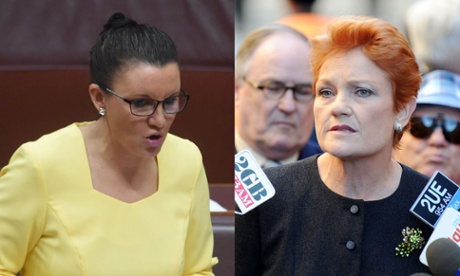Jacqui Lambie's Islam slur: the rhetoric changes, the bigots stay the same
Two
decades ago the rightwing said we would be ‘swamped by Asians’, but no
longer. Even Pauline Hanson’s old party has made the shift to stoking
anxiety over Islam
decades ago the rightwing said we would be ‘swamped by Asians’, but no
longer. Even Pauline Hanson’s old party has made the shift to stoking
anxiety over Islam

‘If you shut your eyes, it could have been 1996.’
Composite: AAP
If you shut your eyes, it could have been 1996.
As many people noted, Jacqui Lambie’s stumbling explanation of sharia law sounded eerily like Pauline Hanson’s notorious xenophobia interview from 18 years earlier.
That was on Sunday. The day before, on the Sunshine Coast, Hanson’s old outfit One Nation was leading an anti-Mosque protest in Maroochydore and telling Muslims to “go back where you come from”.
Yet in Hanson’s 1996 maiden speech
– the presentation that propelled her to fame – she never once
mentioned Sharia. She said nothing about Muslims; Islam wasn’t on her
radar at all.
Back in those days, Hanson had other fish to fry. “I believe we are
in danger of being swamped by Asians,” she told the parliament.
In that speech, she called for a review of immigration policies – but
not to keep Muslims out. She wanted a quite different group to “go back
where they came from”.
“Between 1985 and 1995, 40% of all migrants coming into this country
were of Asian origin,” she said. “They have their own culture and
religion, form ghettos and do not assimilate.”
In those days, One Nation’s official policy on immigration decried
“the Asianisation of Australia”, rhetoric that in 2014 has almost
entirely vanished, even from the far rightwing of politics.
If you search the One Nation
website for “Asian”, you get 10 hits, most of them from old documents.
Search for “Islam”, and the results run for pages and pages.
Now the concerns of Australia’s rightwing have been, as the Telegraph might say, crudely Islamified. Conservative writers worry
about the “Jihadis next door”, express anxiety over “100% halal” Muslim
housing estates, and the spread of headscarves in once-white suburbs.
And when the Daily Telegraph visited an Islamic bookstore in Lakemba,
finding anti-semitic and sexist texts, the paper concluded: “Mix this
level of ignorance and loathing with the Islamic community’s high rate
of unemployment, and conflict is inevitable.”
These concerns are distinctly reminiscent of a passage in historian
Geoffrey Blainey’s 1984 book All for Australia, which he wrote to
amplify and justify an attack on Asian immigration he’d made earlier
that year. In the book, he quotes an anonymous Sydney woman describing
how “[her] suburb as she knows it has vanished”.
“Can I tell you what we have to put up with? Pavements are now
spotted with phlegm and spit because they think it is okay to spit
everywhere and spread germs. They are noisy and entertain late, way past
midnight. They cook on their verandas, so the sky here is filled with
greasy smoke and the smell of goat’s meat.”
She sees the new migrants driving big cars: “I resent seeing ethnics
flying around in flash cars while I have to walk all the time.”
She dislikes the strange smells for the cooking and the smell of the
garbage, and she names the nationalities who, in her view, produce the
worst garbage.
“This block of flats has turned into a slum. Downstairs live, I do
not know how many, Vietnamese in the two flats. They are noisy and park
their cars in inconsiderate places … at one stage, they were even drying
noodles on clotheslines in the backyard.”
Like the Daily Telegraph’s report, which predicted conflict,
Blainey’s interviewee notoriously thought there would be race riots:
“There will be bloodshed in this country.”
Even when the targets are the same, they’re understood differently.
Blainey’s text mentions, in passing, the Lebanese. But insofar as his
interviewee regards Lebanese people as a problem, it’s not because
they’re Muslim. Rather, she sees them as “Asian” – or at least close
enough.
Now the distinction is clear, with conservative writers appealing
to migrant communities that might be “model conservatives”, and warning
of the dangers of “courting Muslim communities too enthusiastically”.
That’s a good example of the arbitrariness of the categorisations on
which prejudice depends. Even when racism relates to directly skin
colour, the interpretation of, say, “blackness” varies immensely from
country to country and from era to era. For instance, historian Henry Louis Gates Jr notes that being “black” in Latin America means something quite different to what it means in the US:
My favorite country to explore this question was the Dominican
Republic. In the Dominican Republic, I spent two weeks asking people who
would definitely be called black in [the United States] how they would
describe themselves. And to a woman or a man, they each described
themselves as “indio,” though overwhelmingly, the mitochondrial DNA goes
straight back to Africa ... But when I asked ‘Who’s black? Who’s
negro?’ they said, ‘Oh, the Haitians. The Haitians are the negroes. We
don’t have any of them here.’
In some places, and in some times, the shape of your nose might
matter immensely – just as in other places and other times, that
characteristic would be entirely irrelevant.
In the 1980s and 1990s, Islam barely registered. Today, however, Cory Bernardi decries multiculturalism,
not as a plot to Asianise Australia, but because “many Australians now
unknowingly consume Halal slaughtered livestock” – a complaint that
would never have occurred to Hanson.
It’s tempting to discuss the mutation of prejudice as an almost
linear evolution, in which each new immigrant cohort suffers the abuse
once heaped upon those who came before. Today, people of Lakemba “refuse
to assimilate”. Yesterday, the same was said about the Vietnamese. The
day before, it was the Greeks and the Italians.
Certainly, there’s a remarkable structural similarity between the
current attacks on Muslims and the denigration experienced by Jewish
arrivals in the 1920s – they, too, were denounced for their
“clannishness”, their strange religious beliefs and dietary customs, and
their alleged connection with political violence abroad (“Jewish
Bolshevism”).
Yet that account – a liberal narrative of unfamiliarity gradually
giving way to acceptance – doesn’t quite explain what’s happening. As
well as denouncing Asians, Hanson famously attacked Indigenous Australia
– and the sentiment she expressed there sounds entirely contemporary.
If anything, the Hansonite attitude to Aboriginal people has become
more mainstream rather than less, even as other attitudes have entirely
shifted. For a settler state like Australia, Indigeneity remains a
perpetually fraught subject, one that calls into question fundamental
issues about national origins.
Equally, responses to immigrants are shaped by an array of factors, not least of which is foreign policy.
In the 1980s, Australia aligned itself with a US that was still
smarting from the Vietnam War and that saw the Asia Pacific in terms of a
Cold War in which Red China posed a major threat.
When, in 1984, the Liberal shadow minister for immigration, Michael
Hodgman, spoke out against Asian immigration, he did so by decrying the
“Hawke socialist government’s profoundly paranoid
anti-British/anti-European bias”.
Today, Australia has been engaged in combat operations of one kind or
another almost without interruption since 2001. The War on Terror thus
provides an obvious filter through which social tensions get processed.
Groups like One Nation, or freelancers like Jacqui Lambie,
opportunistically adapt themselves to the new environment. To put it
another way, the rhetoric changes – but the bigots remain the same.

No comments:
Post a Comment